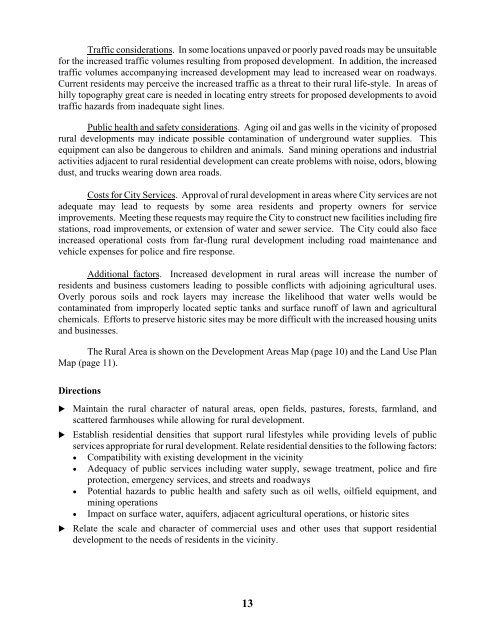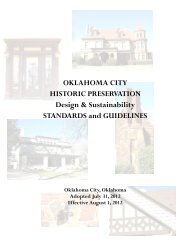OKC Plan, 2000-2020 - City of Oklahoma City
OKC Plan, 2000-2020 - City of Oklahoma City
OKC Plan, 2000-2020 - City of Oklahoma City
Create successful ePaper yourself
Turn your PDF publications into a flip-book with our unique Google optimized e-Paper software.
Traffic considerations. In some locations unpaved or poorly paved roads may be unsuitable<br />
for the increased traffic volumes resulting from proposed development. In addition, the increased<br />
traffic volumes accompanying increased development may lead to increased wear on roadways.<br />
Current residents may perceive the increased traffic as a threat to their rural life-style. In areas <strong>of</strong><br />
hilly topography great care is needed in locating entry streets for proposed developments to avoid<br />
traffic hazards from inadequate sight lines.<br />
Public health and safety considerations. Aging oil and gas wells in the vicinity <strong>of</strong> proposed<br />
rural developments may indicate possible contamination <strong>of</strong> underground water supplies. This<br />
equipment can also be dangerous to children and animals. Sand mining operations and industrial<br />
activities adjacent to rural residential development can create problems with noise, odors, blowing<br />
dust, and trucks wearing down area roads.<br />
Costs for <strong>City</strong> Services. Approval <strong>of</strong> rural development in areas where <strong>City</strong> services are not<br />
adequate may lead to requests by some area residents and property owners for service<br />
improvements. Meeting these requests may require the <strong>City</strong> to construct new facilities including fire<br />
stations, road improvements, or extension <strong>of</strong> water and sewer service. The <strong>City</strong> could also face<br />
increased operational costs from far-flung rural development including road maintenance and<br />
vehicle expenses for police and fire response.<br />
Additional factors. Increased development in rural areas will increase the number <strong>of</strong><br />
residents and business customers leading to possible conflicts with adjoining agricultural uses.<br />
Overly porous soils and rock layers may increase the likelihood that water wells would be<br />
contaminated from improperly located septic tanks and surface run<strong>of</strong>f <strong>of</strong> lawn and agricultural<br />
chemicals. Efforts to preserve historic sites may be more difficult with the increased housing units<br />
and businesses.<br />
The Rural Area is shown on the Development Areas Map (page 10) and the Land Use <strong>Plan</strong><br />
Map (page 11).<br />
Directions<br />
Maintain the rural character <strong>of</strong> natural areas, open fields, pastures, forests, farmland, and<br />
scattered farmhouses while allowing for rural development.<br />
Establish residential densities that support rural lifestyles while providing levels <strong>of</strong> public<br />
services appropriate for rural development. Relate residential densities to the following factors:<br />
• Compatibility with existing development in the vicinity<br />
• Adequacy <strong>of</strong> public services including water supply, sewage treatment, police and fire<br />
protection, emergency services, and streets and roadways<br />
• Potential hazards to public health and safety such as oil wells, oilfield equipment, and<br />
mining operations<br />
• Impact on surface water, aquifers, adjacent agricultural operations, or historic sites<br />
Relate the scale and character <strong>of</strong> commercial uses and other uses that support residential<br />
development to the needs <strong>of</strong> residents in the vicinity.<br />
13

















